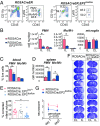PGE2 signaling via the neuronal EP2 receptor increases injury in a model of cerebral ischemia
- PMID: 31036664
- PMCID: PMC6525498
- DOI: 10.1073/pnas.1818544116
PGE2 signaling via the neuronal EP2 receptor increases injury in a model of cerebral ischemia
Abstract
The inflammatory prostaglandin E2 (PGE2) EP2 receptor is a master suppressor of beneficial microglial function, and myeloid EP2 signaling ablation reduces pathology in models of inflammatory neurodegeneration. Here, we investigated the role of PGE2 EP2 signaling in a model of stroke in which the initial cerebral ischemic event is followed by an extended poststroke inflammatory response. Myeloid lineage cell-specific EP2 knockdown in Cd11bCre;EP2lox/lox mice attenuated brain infiltration of Cd11b+CD45hi macrophages and CD45+Ly6Ghi neutrophils, indicating that inflammatory EP2 signaling participates in the poststroke immune response. Inducible global deletion of the EP2 receptor in adult ROSA26-CreERT2 (ROSACreER);EP2lox/lox mice also reduced brain myeloid cell trafficking but additionally reduced stroke severity, suggesting that nonimmune EP2 receptor-expressing cell types contribute to cerebral injury. EP2 receptor expression was highly induced in neurons in the ischemic hemisphere, and postnatal deletion of the neuronal EP2 receptor in Thy1Cre;EP2lox/lox mice reduced cerebral ischemic injury. These findings diverge from previous studies of congenitally null EP2 receptor mice where a global deletion increases cerebral ischemic injury. Moreover, ROSACreER;EP2lox/lox mice, unlike EP2-/- mice, exhibited normal learning and memory, suggesting a confounding effect from congenital EP2 receptor deletion. Taken together with a precedent that inhibition of EP2 signaling is protective in inflammatory neurodegeneration, these data lend support to translational approaches targeting the EP2 receptor to reduce inflammation and neuronal injury that occur after stroke.
Keywords: PGE2; conditional knockout; stroke.
Conflict of interest statement
The authors declare no conflict of interest.
Figures





Similar articles
-
Suppression of inflammation with conditional deletion of the prostaglandin E2 EP2 receptor in macrophages and brain microglia.J Neurosci. 2013 Oct 2;33(40):16016-32. doi: 10.1523/JNEUROSCI.2203-13.2013. J Neurosci. 2013. PMID: 24089506 Free PMC article.
-
AH6809 decreases production of inflammatory mediators by PGE2 - EP2 - cAMP signaling pathway in an experimentally induced pure cerebral concussion in rats.Brain Res. 2018 Nov 1;1698:11-28. doi: 10.1016/j.brainres.2018.05.030. Epub 2018 May 21. Brain Res. 2018. PMID: 29792868
-
Neuroprotective function of the PGE2 EP2 receptor in cerebral ischemia.J Neurosci. 2004 Jan 7;24(1):257-68. doi: 10.1523/JNEUROSCI.4485-03.2004. J Neurosci. 2004. PMID: 14715958 Free PMC article.
-
Prostaglandin receptor EP2 in the crosshairs of anti-inflammation, anti-cancer, and neuroprotection.Trends Pharmacol Sci. 2013 Jul;34(7):413-23. doi: 10.1016/j.tips.2013.05.003. Epub 2013 Jun 21. Trends Pharmacol Sci. 2013. PMID: 23796953 Free PMC article. Review.
-
Prostaglandin EP2 receptor: Novel therapeutic target for human cancers (Review).Int J Mol Med. 2018 Sep;42(3):1203-1214. doi: 10.3892/ijmm.2018.3744. Epub 2018 Jun 26. Int J Mol Med. 2018. PMID: 29956743 Review.
Cited by
-
Inhibiting the PGE2 Receptor EP2 Mitigates Excitotoxicity and Ischemic Injury.ACS Pharmacol Transl Sci. 2020 Jun 25;3(4):635-643. doi: 10.1021/acsptsci.0c00040. eCollection 2020 Aug 14. ACS Pharmacol Transl Sci. 2020. PMID: 32832866 Free PMC article.
-
Chronic Treatment with Nigella sativa Oil Exerts Antimanic Properties and Reduces Brain Inflammation in Rats.Int J Mol Sci. 2024 Feb 2;25(3):1823. doi: 10.3390/ijms25031823. Int J Mol Sci. 2024. PMID: 38339101 Free PMC article.
-
Association of oxidative stress and inflammatory metabolites with Alzheimer's disease cerebrospinal fluid biomarkers in mild cognitive impairment.Alzheimers Res Ther. 2024 Jul 30;16(1):171. doi: 10.1186/s13195-024-01542-4. Alzheimers Res Ther. 2024. PMID: 39080778 Free PMC article.
-
Modulating inflammatory prostaglandin E2 signaling to mitigate neurobehavioral comorbidities associated with seizure disorders.Acta Pharm Sin B. 2025 May;15(5):2351-2362. doi: 10.1016/j.apsb.2025.03.024. Epub 2025 Mar 13. Acta Pharm Sin B. 2025. PMID: 40487634 Free PMC article. Review.
-
Suppression of PGE2/EP2 signaling alleviates Hirschsprung disease by upregulating p38 mitogen-activated protein kinase activity.J Mol Med (Berl). 2023 Sep;101(9):1125-1139. doi: 10.1007/s00109-023-02353-0. Epub 2023 Jul 31. J Mol Med (Berl). 2023. PMID: 37522903
References
-
- Kawano T, et al. (2006) Prostaglandin E2 EP1 receptors: Downstream effectors of COX-2 neurotoxicity. Nat Med 12:225–229. - PubMed
Publication types
MeSH terms
Substances
Grants and funding
LinkOut - more resources
Full Text Sources
Other Literature Sources
Molecular Biology Databases
Research Materials
Miscellaneous

